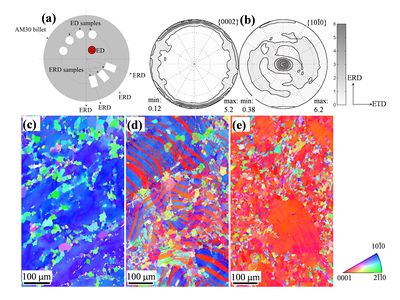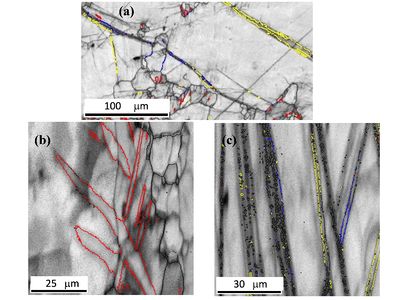Integrated Computational Materials Engineering (ICME)
Twinning and double twinning upon compression of prismatic textures in an AM30 magnesium alloy
Abstract
Twinning mechanisms in a {1 0 \overline{1} 0} -fiber texture of an AM30
magnesium alloy were studied under profuse and nominal {1 0 \overline{1} 2}
twinning conditions produced by different compression orientations. While {1 0
\overline{1} 2} twins took the form of fully residual twins upon profuse
conditions, they were “stopped elastic” twins upon nominal conditions. Profuse
nucleation of {1 0 \overline{1} 1}–{1 0 \overline{1} 2} and {1 0\overline{1}
3}–{1 0 \overline{1} 2} double twins occurred as a two-shear mode mechanism
which substantiated Crocker’s theory of double twinning. These two double
twinning modes played an important role in rushing sample fracture[1].
Author(s): Q. Ma, H. El Kadiri, A.L. Oppedal, J.C. Baird, M.F. Horstemeyer, and M. Cherkaoui
Methodology
Although twinning in magnesium alloys has been the subject of substantial experimental and numerical studies, the reported results usually concerned samples brought up to fracture.In fact, only few studies have characterized the mechanisms of twinning upon small and intermediate strains. Therefore, for developing reliable polycrystal plasticity models capturing the effect of slip-twin interaction on hardening, essential is to understand the mechanisms driving twinning activity at small and intermediate strains.In this study, we aim to characterize twinning from initial yield upon compression to rupture of a {10-10}-fiber textured AM30 magnesium alloy. Two directions were selected to study twinning upon both profuse and nominal conditions. The Electron BackScattered Diffraction (EBSD) technique was used to analyze the microtexture, which was supported by additional macrotexture analyses using X-Ray Diffraction (XRD) method.The sample main axis was either parallel to ED or parallel to ERD. To minimize scatter in the stress-strain curves and texture, both ED and ERD samples were machined from the same area which was near a mid-radius of the billet as shown in Figure 1.Both types of samples were brought to -0.036, -0.06, -0.088 true plastic strain levels and also to rupture. All samples were tested at room temperature and at a strain rate of 10-3s-1. Profuse extension twinning activated compression along the ED direction as shown in Figure 1. Whereas at last stage, two types of double twins coexisted in the matrix grain as shown in Figure 2a. Compression along ERD, the contraction twinning and a time-sequence {10-11}-{10-12} double twinning occurred. At last stage, non-time sequence of two types of double twinning originated in matrix grain as shown in Figure 2b.
Material Model
The {1 0 1 1}h1 0 1 2i contraction twin mode had in fact nucleated in a profuse fashion exclusively on the {1 0 1 2} twins before rupture took place. In addition, the {1 0 1 3}h3 0 3 2i was detected in the ED fractured sample within the extension twinned region. Furthermore, both {1 0 1 1}h1 0 1 2i and {1 0 1 3}h3 0 3 2i twinning occurred as double twinning within the {1 0 1 2} extension twins, so the two third-order twinning sequences, {1 0 1 2}–{1 0 1 1}– {1 0 1 2} and {1 0 1 2}–{1 0 1 3}–{1 0 1 2}, took place. The {1 0 1 1} contraction twin mode is actually a degenerate compound twinning with twin elements K1 = {1 0 1 1}, g2 = h3 0 3 2i, K2 = {1 0 13} and g1 = h1 0 12i [11]. It has the {1 2 1 0} plane of shear, which is a mirror plane, and the motif unit lies well within this plane of shear. As a consequence, this {1 0 1 1} contraction twin system with K1, g1, K2 and g2 rational elements is favored by its low twinning shear (0.137). However, all contraction twins were entirely twinned by the extension twins except for regions near the tip. This does not imply an independent and subsequent twinning sequence; rather, as suggested by Crocker [12], extension twinning occurs simultaneously during the growth of the contraction twins to facilitate the complex shuffle required at the tip of the growing {1 0 1 1} twin.

Figure 1. (a) The ED and ERD samples in the AM30 billet; (b) the initial texture of AM30 alloy based on XRD; EBSD IPF maps of ED samples at strain (c) 0; (d) -0.036; (e) -0.088 showing extension {10-12}<10-10&gr; twin development. (The loading direction is out of paper. Inverse pole figure represents the ED direction.)

Figure 2. The {10-11}-{10-12} double twin and {10-13}-{10-12} double twin evolved in the totally twinned matrix grain in the ED rupture sample; (b)The primary extension {10-12} twins in the ERD sample at strain -0.06 and (c) the {10-11}-{10-12} and {10-13}-{10-12} double twins in the ERD rupture sample. Fine black lines refer to grain boundaries >15 degree.)
Results
In summary, compression along and normal to a {10-10} fiber in magnesium led to a complex twinning multiplicity. Along the fiber, active twinning modes included the first primary {10-12} twinning, the {10-11}-{10-12} and {10-13}-{10-12} double twinning within the primary {10-12} twins. The double twinning occurred as a combined two-shear mechanism with profuse activity right before sample fracture. Normal to the {10-10} fiber, the primary {10-12} and {10-11} twins both occurred with the primary {10-11} twins activating at a lower stress than secondary {10-11} twins parallel to the fiber with grains showing a similar Schmid factor. The {10-11} contraction twins were followed by the secondary {10-12} twinning evolving within the primary {10-11} twins. The combined two-shear mode of {10-13}-{10-12} and {10-11}-{10-12} double twinning was also profuse before rupture. The extension {10-12} twin took the form of full residual twin parallel to the fiber and of “stopped elastic” twin normal to the fiber.
Acknowledgments
Center for Advanced vehicular systems (CAVS) at Mississippi State Univevrsity
References
1. Q. Ma, H. El Kadiri, A.L. Oppedal, J.C. Baird, M.F. Horstemeyer, and M. Cherkaoui, “Twinning and double twinning upon compression of prismatic textures in an AM30 magnesium alloy,” Scripta Materialia, Volume 64, Issue 9, May 2011, Pages 813–816. DOI: 10.1016/j.scriptamat.2011.01.003.
